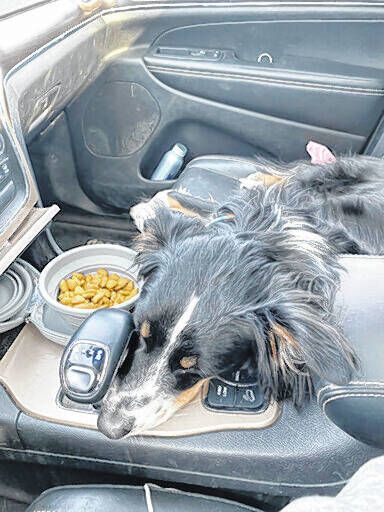
Javi, an Australian shepherd-border collie mix, sleeps in a car during a road trip from Los Angeles to San Francisco with his owner Ben Lowenstein in February 2022. Lowenstein loves to travel and he never leaves his dog, Javi, behind.
Ben Lowenstein via AP
Click here to subscribe today or Login.
San Francisco dog owner Ben Lowenstein loves to travel — and he never leaves his dog, Javi, behind.
Together, the pair has taken road trips to Chicago, Lake Tahoe and Los Angeles. They have hiked the trails of New Mexico, explored Utah’s national parks, and gallivanted through Colorado snow banks.
The best part of traveling with Javi, says Lowenstein, is that his best friend is always with him. He loves when Javi rests his head on the console of the car and falls asleep as they wind their way to their next adventure.
But road tripping with a dog isn’t all beautiful moments. It can be challenging for both the dog and owner. Tips for helping your four-legged pal succeed on the road:
1. Teach them to love the car.
Long before your road trip, give your dog positive associations with the car.
“Practice makes better,” says Erdem Tuncsiper, who runs P.A.C.K. Leaders Dog Training in Chicago. “Don’t make your big trip their first trip.”
Take them on as many local drives as possible, and give them treats and toys to make the car fun. Drive them to exciting places so they don’t see the car as a direct-to-vet delivery mobile.
If a dog is apprehensive, pet parents “can encourage further engagement with the car by rewarding all interaction directed toward the vehicle — such as looking at, sniffing, moving toward or stepping into — and proceeding with baby steps from there,” says Darris Cooper, national dog training manager at Petco.
Bring along items like bowls and blankets that your dog is not only used to, but finds comforting, says Tuncsiper.
“This includes anything for sleeping, eating or drinking,” he says.
2. Keep your dog as comfortable as possible.
“Make sure your dog is not stressed by the sights, sounds or movement of the vehicle,” says Dr. Natalie Marks, a veterinarian at Chicago’s VCA Blum Animal Hospital. “There are lots of additions that can help reduce stress, like playing classical music, spraying pheromones to help relaxation…, appropriate restraint device training, favorite treats, and not feeding at least two hours before the start of travel to help avoid nausea.”
Dogs also overheat easily, so provide good ventilation (and never leave them alone in a parked car).
“If your dog pants a lot, he is hotter than you are and needs air,” Tuncsiper said.
Excessive panting can also be a sign of anxiety. If your dog just can’t seem to get comfortable, speak to your vet about anti-anxiety medications, as well as over-the-counter chews and drops.
3. Expect the trip to take longer.
Dogs need regular stops to run around, relieve themselves and explore all the new, exciting smells.
“We have a two- or three-hour drive-time rule in our family,” says Christina Howitt, co-founder of Find Your Blue, a Kansas City-based travel company specializing in dog-friendly itineraries. “We always make a point to add frequent stops… We also try to avoid driving more than five or six hours total in a day.”
4. Pack your pup’s suitcase responsibly.
Dogs need a lot of stuff when they travel. Marks says the checklist should include medications, vaccination records, a canine first-aid kit, an extra leash and collar, their ID tag, a crate (in case you need to leave your dog alone where you’re staying) and collapsible bowls.
Bring at least two days’ worth of extra food and water.
There are water bowls that hook to your car so your dog can drink whenever they want. Howitt recommends a no-spill bowl by RocKur Designs: “It can easily be collapsed and taken on hikes. We pair this with a hydration backpack to refill the bowl.”
5. Safety First.
In case of emergency, map out veterinary clinics along your route in advance.
And look into the many products designed to help keep your dog safe in the car.
“Supplies such as a booster seat, travel carrier, crash-tested harness, seat belt adapter… are critical for road trips,” says Cooper, of Petco. “Restricting your dog’s movement helps decrease the chance of injury in an accident.”
6. Find dog-friendly spots in advance.
Traveling with a dog requires more advance planning and less spontaneity.
“Do your research ahead of time, especially for hotels and sightseeing,” advises dog owner Leksa Pravdic, who drove with her dogs, Scout and Pluto, from their home in Chicago to New Mexico, Arizona and Colorado. “A lot of national parks don’t allow dogs or limit their access to certain small areas. Look for national monuments or state parks that allow dogs.”
7. Enjoy the ride.
“Have fun and introduce them to everything,” says Tuncsiper. “Let them smell the new things you buy and do.”
Pravdic agrees. “Even though sometimes the logistics can be a hassle, taking road trips with my dogs has been 100% worth it,” she says. “They are happy to be with you, wherever you go.”





